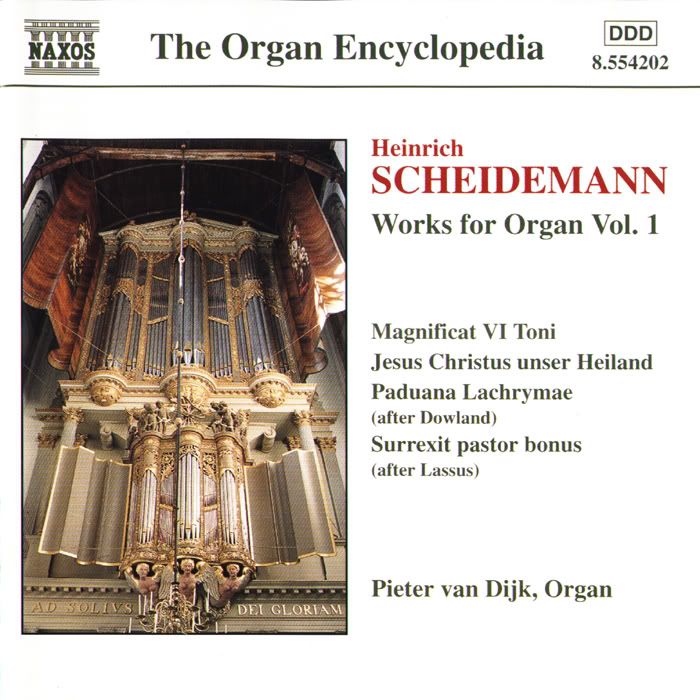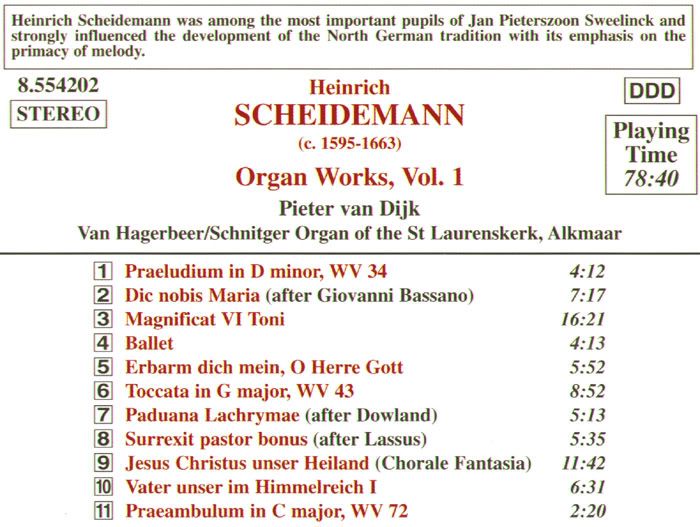 |
| NetLab · Rules · Torrent Tracker · Have a problem? · Eng/Rus |
 Help Help
 Search Search
 Members Members
 Gallery Gallery
 Calendar Calendar
|
| Welcome Guest ( Log In | Register | Validation ) | Resend Validation Email |
|
Posted: 25-04-2010, 22:31
(post 1, #959643)
|
||||||||||||||||||
|
Pro Member Group: Members Posts: 695 Warn:0% |
Heinrich Scheidemann (1595 - 1663) Organ Works, Vol.1 Label: Naxos, 8.554202 Year: 1998 Performer: Pieter van Dijk - organ Tracklist: 01. Praeludium in D minor, WV 34 02. Dic nobis Maria (after Giovanni Bassano) 03. Magnificat VI Toni 04. Ballet 05. Erbarm dich mein, O Herre Gott 06. Toccata in G major, WV 43 07. Paduana Lachrymae (after Dowland) 08. Surrexit pastor bonus (after Lassus) 09. Jusus Christus unser Heiland (Chorale Fantasia) 11. Praeambulum in C major, WV 72 Total Playing Time: 01:18:38 Heinrich Scheidemann belongs, with Jacob Praetorius the Younger, among the most important North German pupils of Jan Pieterszoon Sweelinck. Johann Mattheson described Sweelinck as the maker of Hamburg organists. In the first half of the seventeenth century those in charge of the four principal city churches regarded it as important to see that the positions of organist were held by pupils of Sweelinck. This policy is clearly established in the case of Scheidemann and Praetorius at the beginning of the century, when the churches undertook the full costs of training in Amsterdam over several years for the son of the organist at the Catherinenkirche, David Scheide-mann, and of the Jacobikirche organist Hieronymus Praetorius. Scheidemann began his period of study with Sweelinck in November 1611 and on the completion of his studies in November 1614 was rewarded by Sweelinck with a dedicatory canon, an expression of the esteem in which the latter held him. The importance of Scheidemann may be measured by the range of his work and by comparison with Jacob Praetorius he may be seen as having had a greater influence over the development of the organ style of his contemporaries in North Germany. Mattheson describes the stylistic difference of the two organists in connection with the later organist of the Jacobikirche, Mathias Weckmann, who sought, he wrote, to temper the severity of Praetorius with the grace of Scheidemann. The severity of Praetorius refers to his strict five-part counterpoint, as opposed to the four-voice texture of Scheidemann in which he certainly makes use of contrapuntal technique, but does not afford this primacy of place, rather stressing attractiveness of melodic writing. Shortly after taking up his duties, Scheidemann, who succeeded his father in 1629, saw to it that between 1631 and 1633 the Dresden organ-builder Gottfried Fritzsche rebuilt the organ of the Catharinenkirche, extending the Brustwerk and adding a fourth manual. The organ was consequently an example of the height of contemporary technical achievement, able to ensure an expressiveness through changes of manual and tone-colour, for example with echo effects. Apart from a quantity of sacred songs, Scheidemann's surviving compositions consist largely of keyboard works. For this reason the church music written by Scheidemann as organist of the Catharinenkirche naturally occupies has pride of place. Here may be distinguished chorale arrangements on a cantus firmus, motet arrangements and free compositions without cantus firmus. While it is clear that the first two forms are for the large church organ, it is not always easy to decide whether the freely composed works are intended for church or chamber performance, and some, at least, might be for stringed keyboard instruments. In the case of the present recording the allocation of instrument generally offers no problem, since the Praembulum in C major with its pedal part and the Toccata in G major with its changes of manuals can only be played on the church organ, while the Ballet and Paduana Lachrymae (the latter based on the most famous song by John Dowland) can be classified from their titles as secular works. Only in the case of the Praeambulum in D minor, for manuals only, is a clear allocation impossible, since the piece survives in an organ source from Luneburg and in a harpsichord source from Uppsala, although the writing probably excludes the use of the larger organ. In Scheidemann's chorale versions cyclic arrangement predominates in up to four verses with a different technique each time. The first verse is in four parts throughout and brings out the chorale melody, whether in the tenor as in Erbarm Dich mein, O Herre Gott or in the bass as in Vater unser im Himmelreich. The arrangement of the later verses is variable. When there are more than two verses, as in Vater unser im Himmelreich, a verse can be treated with unornamented cantus firmus in a three- or two-part arrangement, as in the last verse of Vater unser im Himmelreich. In marked contrast to cyclical writing of this kind is the major form of the chorale fantasia, which, unlike verse arrangements in which the chorale is played once and continuously, is a composition based on a cantus firmus. Only three complete chorale fantasias by Scheidemann (with the exception of the second verses of the Magnificat versions) survive, two in three parts and the four-part fantasia here included, on Jesus Christus, unser Heiland. The individual chorale lines come there in very different technical arrangements, repeated one after the other, with the chorale melody in places barely perceptible through the ornamentation used. In the chorale fantasia Scheidemann is able to give expression to his general artistic understanding, where the arrangement of a chorale theme serves only as an external reason and the purely liturgical function of the chorale is not to the fore. We can hear similar tendencies to individuality of expression in a major form in the example of free composition in the Toccata in G major. A particular feature of chorale arrangement is provided by Scheidemann's Magnificat versions, which he sets using all the eight church modes. All use a generally similar cyclic form in four verses, following the same pattern. At the beginning, as with the other chorale arrangements, comes the chorale in four parts. Second there follows a four-part chorale fantasia and third a so-called Chorale Ricercar in which the melody is treated in imitation through all the parts in the style of a motet. Finally the chorale melody is heard again in a three-part setting. The motet variations written by Scheidemann early in his career were for long dismissed as mere ornamentations of pre-existing works, serving as substitutes for choral performance. These are now revealed once more as master-works of distinctive individuality, very suitable for concert performance.  
This post has been edited by kgkk on 25-04-2010, 22:34 |
||||||||||||||||||
|
|||||||||||||||||||
|
Posted: 10-04-2015, 13:12
(post 2, #1104060)
|
||
|
Unregistered |
thanks |
||
|
|


Powered by Invision Power Board v1.3.1 Final.

